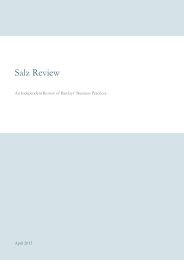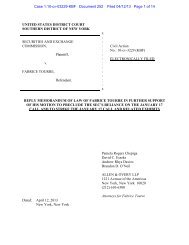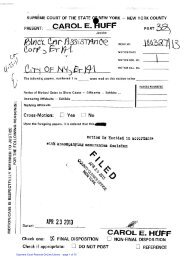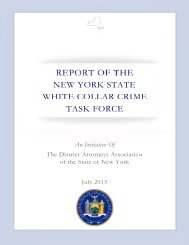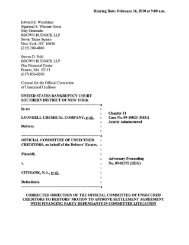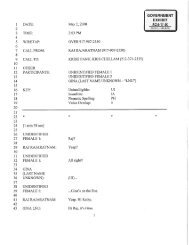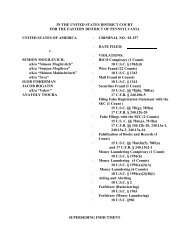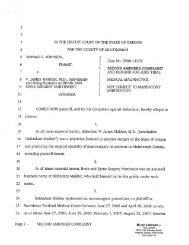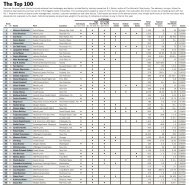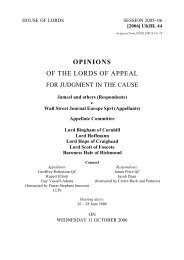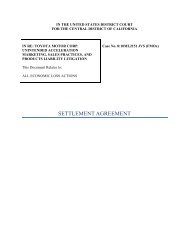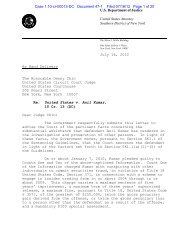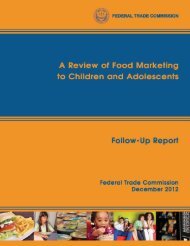Excerpts from the depositions - Wall Street Journal
Excerpts from the depositions - Wall Street Journal
Excerpts from the depositions - Wall Street Journal
Create successful ePaper yourself
Turn your PDF publications into a flip-book with our unique Google optimized e-Paper software.
Case 2:11-cv-10549-MRP-MAN Document 254-1 Filed 03/28/13 Page 34 of 35 Page ID<br />
#:16623<br />
it your expectation that those advisers would be exploring ways to pursue those claims?<br />
A. Yes.” 168:3–16.<br />
• “Q. Am I correct that through <strong>the</strong> period of early 2011, which is when you told us <strong>the</strong><br />
Investment Committee dissolved, you’re not aware of any discussions with or among ML<br />
II’s advisers about pursuing recoveries with respect to any AIG assigned tort claims?<br />
[Objection] A. I am not aware of any such discussion.” 169:14–24.<br />
Mahoney testified that <strong>the</strong> FRBNY created ML II in order to secure AIG’s ongoing viability.<br />
• “Q. And you agree that it was not <strong>the</strong> purpose of <strong>the</strong> New York Fed to try to make a<br />
profit in connection with ML II? A. . . . [W]e did not have a profit motive in entering<br />
into Maiden Lane II.” 120:24–25.<br />
• “Q. . . . Was it your view—First of all, was <strong>the</strong> restructuring done at least in part to assist<br />
AIG in avoiding a ratings downgrade? A. It was responsive to <strong>the</strong> concerns of a<br />
variety of [stake] holders. And important [stake] holders <strong>the</strong>re were <strong>the</strong> credit<br />
rating agencies.” 282:21–283:6.<br />
• “Q. But at that point in time, you believed that those four components of <strong>the</strong><br />
restructuring— A.—avoided a near term downgrade by <strong>the</strong> rating agencies, yes. Q.<br />
And did you believe that, at least in <strong>the</strong> near term, it assured AIG’s viability? A. In <strong>the</strong><br />
near term, yes. Q. And <strong>the</strong>n you’re saying that <strong>the</strong>re was always risk and you didn’t<br />
know what <strong>the</strong> future had in store, but at least at that point in time, you believed it was<br />
sufficient for AIG to continue as a going concern, correct? A. Going concern. Q. And to<br />
be a viable entity, correct? A. Right.” 283:14–284:7.<br />
• “Q. And you agree that it was not <strong>the</strong> purpose of <strong>the</strong> New York Fed to try to make a<br />
profit in connection with ML II? A. We have policy objectives in creating <strong>the</strong><br />
instrument. The LIBOR plus 100 interest rate would be a low interest rate relative<br />
to what a private sector institution would require for <strong>the</strong> risk that were being<br />
obtained. So, we did not have a profit motive in entering into Maiden Lane II.”<br />
120:15–25.<br />
Mahoney testified that <strong>the</strong> FRBNY’s loan to ML II was always extremely likely to be repaid.<br />
• “Q. And is it true, sir, that all of those outside advisers, after evaluating <strong>the</strong> collateral,<br />
<strong>the</strong>ir conclusions were that <strong>the</strong> New York Fed was unlikely to take any losses on <strong>the</strong> loan<br />
even in severe stress scenarios? [Objection] A. That is <strong>the</strong> conclusion that our<br />
advisers arrived at, communicated to us, and which we understood.” 71:6–14.<br />
• “Q. And in all of those instances, all of your advisers—in o<strong>the</strong>r words, in all of those<br />
scenario, stress test scenarios, your advisers’ conclusions were that, even under <strong>the</strong><br />
worse stress case scenario that <strong>the</strong>y used, <strong>the</strong>ir model showed that <strong>the</strong> Fed’s loan would<br />
be repaid in full, correct, sir? A. That is <strong>the</strong> results of <strong>the</strong>ir modelling, yes.” 72:2–10.<br />
• “Q. [Referring to BlackRock presentation] [I]t says ‘Very low likelihood of failing to<br />
repay senior debt (P&I)’—principal and interest—’even under extremely severe stress<br />
scenarios.’ Do you see that? A. Yes, I do. Q. And that was BlackRock’s view at <strong>the</strong><br />
time, correct? A. So, it was <strong>the</strong>ir view at <strong>the</strong> time, but maybe you can reinterpret<br />
that that was <strong>the</strong>ir direction to structure something that would pay off <strong>the</strong> Federal<br />
Reserve principal plus interest even under extremely stressed scenarios. Q. And is it<br />
EXHIBIT 4<br />
10



